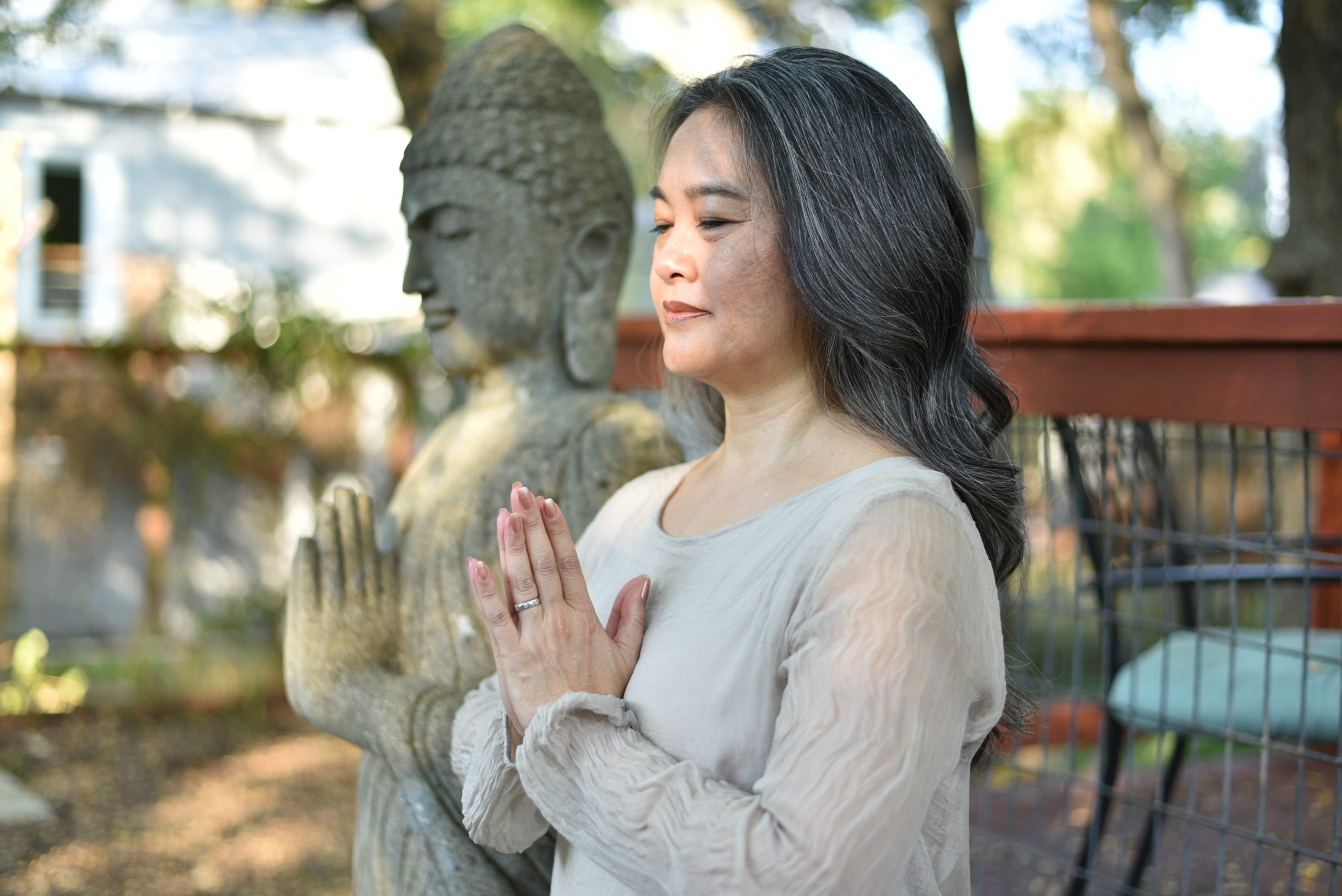Breathwork and Meditation for the Workplace
Breathwork Basics
With the eyes closed, the gaze can be directed inward towards the third eye point to help stimulate the pituitary gland. If you need to keep the eyes open to stay aware of your surroundings, focus on a single point in front of you along the horizon or lower.
Long Slow Deep Breath
Is one of the basic breaths from which other breath techniques arise. Expand the belly as you breathe in slowly and smoothly through the nose. As you continue inhaling, feel the ribcage expand and the top of the chest rise. Keep the chest lifted and exhale slowly and completely from the top of the chest, the mid-chest, drawing the abdomen back towards the spine last. This type of breathing is centering. It relaxes the nervous system and can lower heart rate and blood pressure. This is a great breath to do in the face of adversity.
Breath of Fire
Is just like long deep breathing except faster. Breathe in and out through the nose rhythmically and quickly, 1-3 breaths per second. There is no pause between the inhale and exhale, and they are of equal proportion. The body and face are relaxed while performing this breath. The abdomen pumps as it expands with the inhalation and contracts with he exhalation. With practice, it feels effortless. Until the body becomes accustomed to breathing in this way, use long deep breathing as your rest period, and then begin breath of fire again whenever you are ready. Breath of fire is an energizing breath to help focus the mind. It assists with determination. Other benefits include detoxification, boosting the immune system, oxygenating the blood, increased lung capacity, energy and stress resistance. Anecdotal evidence suggests improved vision immediately after practice. This breath is not recommended for those who are pregnant, have uncontrolled high blood pressure or seizures.
Desk Exercises to Help Counter the Effects of Sitting for Long Periods
Pelvic Grinds
Sit towards the edge of your seat with your feet flat on the floor. The spine is tall, chest is lifted, lower abdomen engaged (drawn back towards the spine) about 20%. Place the hands atop the thighs. Begin to rotate from the base of the spine. As you inhale, circle halfway one direction and exhale as you complete your circle. Keep the spine lengthened, chin tucked half inch down and half inch back to maintain the integrity of the cervical spine. Make several rounds. Then pause and begin circling in the opposite direction using the same breath pattern. To end, begin making smaller and smaller circles as you make your way back towards center. Once there, inhale, pause, and exhale to relax. This exercise helps promote regularity with the lower body’s eliminative functions.
Spinal Flexes
Sit towards the edge of your seat with your feet flat on the floor. The spine is tall, chest is lifted, lower abdomen engaged about 20%. Place the hands atop the thighs. Inhale and flex the spine forward lifting up through the top of the chest. Exhale to round the back. Continue. The chin remains parallel to the floor. Shoulders remain stacked over the hips. Move within a pace and range of motion that works for you. To end, inhale to a neutral spine, pause, and exhale to relax. This exercise helps move the cerebrospinal fluid through the vertebrae and discs, promoting flexibility of the spine.
Shoulder Shrugs
Sit towards the edge of your seat with your feet flat on the floor. The spine is tall, chest is lifted, lower abdomen engaged by about 20%. Place the hands atop the thighs. Shrug the shoulders up towards the ears with the inhale and exhale drop the shoulders down. Should there be any concerns with the neck and shoulders, lower the shoulders with control rather than dropping them. This exercise helps to loosen up the shoulders and neck, aiding with the breakup of calcium deposits.
Neck Rolls
Sit towards the edge of your seat with your feet flat on the floor. The spine is tall, chest is lifted, lower abdomen engaged by about 20%. Place the hands atop the thighs. Imagine that your nose is a piece of chalk and there is a chalkboard in front of your face. Begin drawing big circles on that imaginary chalkboard with your nose, inhaling as you circle up and exhaling as you circle down. Only bring the head as far back as is comfortable for you. To switch the rotation, roll the chin down, pause, and then begin circling the head in the opposite direction. To end, roll the chin down and inhale to bring the head back up to neutral. This exercise releases tension in the neck.
Suggested Daily Practices
Ego Eradicator
Is a great practice to do in the morning, though it can be done any time of day. Sit with the spine lengthened, either in a comfortable cross-legged position or sitting in a chair with the feet flat on the floor. Raise the arms to a 60-degree angle. Palms face forward. Curl the fingertips down to the tops of the palms, keeping the palms open. Point the thumbs up and towards each other. Begin breath of fire. Continue for 3 minutes or up to an hour. Along with all the benefits of breath of fire (please see above for benefits and contraindications), this practice also strengthens the diaphragm, shoulders and arms. It brings the brain into a state of alertness.
Alternate Nostril Breathing (Variation)
Although it can be done any time, this variation of alternate nostril breathing is a great practice before bed. It helps to release the cares and worries of the day while lowering stress and improving cardiovascular function. Sit with the spine lengthened, either in a comfortable cross-legged position or sitting in a chair with the feet flat on the floor. Close off the right nostril with the right thumb and inhale slowly and smoothly through the left nostril. To exhale, close off the left nostril with your forefinger or pinky finger and breathe out slowly and smoothly through the right nostril. Continue this breath pattern for up to 11 minutes. To end, inhale through the left nostril, lower your hand, and breathe out through both nostrils.
Be With the Heart
Place your right hand on top of your sternum in the middle of your chest. Place your left hand over your right. Feel the energy in your hands, your heart, and the spine behind your heart. All you need to do is be with yourself. Practice being present. As you practice this and become more in tune with your heart, use this meditation to communicate with your heart center. When you feel stuck and your mind has a hard time figuring out an answer, ask your heart for a response so that you can begin getting answers from your heart instead of your head. Stay with your heart for 3-11 minutes. Then inhale deeply, pause, exhale, and slowly open your eyes.
Dealing with the Mind
This meditation is beneficial when your mind runs amuck. It can be done any time. Close the right nostril with the right thumb, pointing the remaining fingers up in a relaxed way. Breathe in slowly and smoothly through the left nostril. Breathe out smoothly and slowly through the mouth. Continue this breath cycle for up to 6 minutes. To end, inhale through the left nostril, lower your hand, and breathe out through both nostrils. Interlace the fingers, invert the hands and inhale while raising the arms overhead pointing the palms up towards the ceiling. Pause. Exhale and gently sweep the arms down. Relax.
fSign up for Xenia's mailing list and find out about events, discounts, special classes and more!

